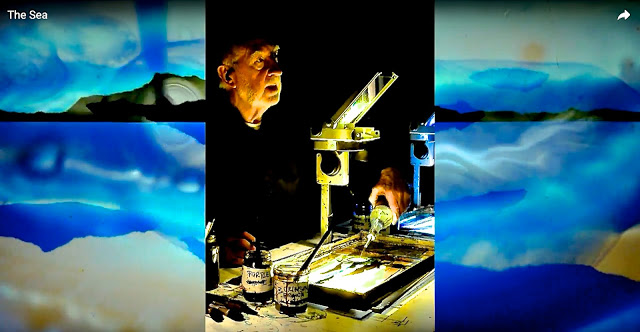The joy of fluid lyrical painting
Of course you know that lyrics are the words to a song. But did you know that lyrical paintings can sing without words and elevate you emotionally? The continuous flow of my kinetic colours is like a song, the tones fluctuating with the help of my instruments (my brushes). As they visualise the rhythms of this music for you on screen, this extraordinary partnership offers you an intensely lyrical experience, maybe even a sense of rhapsody.
A still from my kinetic painting to "Incantation", Part 4 of "Murmurs in the Mist of Memory"
by Augusta Read Thomas.
Lyrical Abstraction was born of a desire to create a direct physical and sensory experience of painting, one of the many styles of painting that developed in the second half of the twentieth century in Paris and the United States, for example in Jackson Pollock's "drip and splash" painting, or the Color Field movement (poured paint and stained canvasses) pioneered by Helen Frankenthaler. Those paintings reveal an intuitive loose handling in the physical application of the paint, its sensuous organic properties and the breath or energy of the artist in action. You sense their exalted state as they exhale, following the energy of the liquid as it takes on a life of its own. Jackson Pollock listened to jazz for hours, before he walked across his canvasses to make his drip paintings. Click on the link to the PBS video of Jackson Pollock to see the photos and hear the story of the creative act as a kind of performance art. Those huge canvasses now hang on museum walls and still give you some impression of the action, but as you gaze at them, you realise that you've actually come too late. The action has become frozen, fixed on canvas and framed - in a form that is commercially very profitable.
Jackson Pollock in action. Photo By Martha Holmes/The LIFE Premium Collection/Getty Images
By contrast, my own lyrical moving painting only exists in "real time": an ephemeral performance-art form, its existence determined by the length of the music. When the music stops, it disappears, gone for ever. A truly unique experience for the cost of a mere concert ticket. Admittedly you can put it on video, but the surprise and excitement of the original performance will never be the same. The other feature of my own sort of "lyrical painting" is that is not vaguely inspired by the music in some general way. It's specifically choreographed to each piece of music. Although it is often extremely dynamic, unlike Pollock's work it will likely convey you gently to a more peaceful world.
Here's the Link to the City of Birmingham Symphony Orchestra's video of my brief introduction to my painting to The Sea by Čiurlionis.
Both the dream-like mystical paintings of the Lithuanian composer M.K. Ciurlionis (1875-1911) and his poetic music express emotional torment and a longing for a state of spiritual ecstasy, of exaltation. Every colour evokes a tone that sings the praises of mother Nature. More than any other composer, his paintings and music go hand in hand, his music dying to be visualised and his paintings crying out to be performed live. Like his contemporary Alexander Scriabin with his Poem of Ecstasy and Prometheus, he was already looking for a combined audio-visual art form.
I can't wait to stand on stage on February 16th. with my overhead-projector set-up, surrounded by about a hundred musicians of the City of Birmingham Symphony Orchestra conducted by Mirga Gražinytė-Tyla, to paint/play M.K.Čiurlionis' lyrical, emotional symphonic poem The Sea (1907), my colours "singing" in an audio-visual harmony. I know this will be a deeply emotional experience for me, probably for Mirga on Lithuania's Independence Day (February 16th) and hopefully for you too.
Link to my performance with the CBSO, in Birmingham Symphony Hall, Saturday February 16th.








prachtig en inspirerend, ook lett. er zit adem in...
ReplyDeleteWow, Lyrical painting. Learnt a new thing. Art of painting can take many shapes you just have to learn how to play with colors
ReplyDeletei Just loved your taste of painting your imagination is on another level.
ReplyDelete